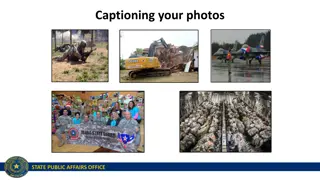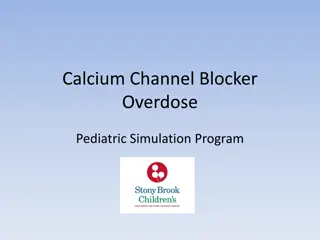
Essential Steps for School-Based Telehealth Program Success
Developing a school-based telehealth program requires a strategic approach involving needs assessment, goal setting, local partnerships, and compliance with regulations. Measurable goals, understanding local resources, and adherence to legal requirements are crucial for successful implementation. By following key steps like needs analysis, defining services, and engaging with local health resources, schools can effectively plan and execute a sustainable telehealth program.
Download Presentation

Please find below an Image/Link to download the presentation.
The content on the website is provided AS IS for your information and personal use only. It may not be sold, licensed, or shared on other websites without obtaining consent from the author. If you encounter any issues during the download, it is possible that the publisher has removed the file from their server.
You are allowed to download the files provided on this website for personal or commercial use, subject to the condition that they are used lawfully. All files are the property of their respective owners.
The content on the website is provided AS IS for your information and personal use only. It may not be sold, licensed, or shared on other websites without obtaining consent from the author.
E N D
Presentation Transcript
Loren Nix, RN, BSN Director Of School Health+ Global Partnership For Telehealth loren.nix@gpth.org DISCLOSURE: I AM AN EMPLOYEE OF GLOBAL PARTNERSHIP FOR TELEHEALTH
Needs Analysis & Environmental Analysis Define Services, Program Model and Technology Models SEVEN STEPS TO TELEHEALTH SUCCESS Business Model Development Development of Detailed Implementation Plan CALIFORNIA TELEHEALTH RESOURCE CENTER S PROGRAM DEVELOPER HTTP://WWW.CALTRC.ORG/KNOWLEDGE- CENTER/CTRC-PRODUCTS/ Development of Performance Monitoring Plan Program Implementation Monitor and Improve
A IS FOR ASSESS
NEEDS ASSESSMENT Even though it may sound easy, starting a school-based telehealth program can be costly, time consuming and challenging. Schools and/or their sponsoring organizations that perform a formal assessment have the advantage of identifying potential problems and addressing them early. Schools that perform needs assessments gain support for the project by engaging people early. A needs analysis will help your organization identify key unmet needs and will help you devise effective strategies and approaches to meet them. A needs assessment will give you a clear understanding of the nature and scope of your program, provide a sound foundation for planning, help you clarify objectives and shared expectations, and improve coordination of services and resources.
GOALS AND OBJECTIVES Measurable goals and objectives will assist in selecting equipment, developing staffing, evaluating performance, and creating sustainability. Measurable goals are necessary for every facet of program design and development. Findings from the needs assessment should be used to form goals and objectives. Have a clear understanding of the types of services and telehealth program model needed to implement in your school.
LOCAL RESOURCES AND PARTNERS From the needs assessment, local health resources that could partner with the school to provide telehealth services should be identified. Discuss the school-based telehealth ideas with these potential partners to determine their level of interest. With any telehealth program, the local medical community should never be overlooked as viable partners for the school s telehealth plan.
RULES There are a wide range of legal and regulatory issues and requirements that must be understood and met when developing a telehealth program. These regulations and laws are different in each state and change frequently. Be aware of all pertinent laws as you develop your plan for school-based telehealth. Ensure your school district s administration, board of education, and legal counsel are fully informed of your plans well in advance of implementation to allow time for complete legal reviews.
EQUIPMENT Select the right equipment for your school-based telehealth program s determined services and delivery model. Video equipment, communication systems, medical devices and software applications are critical equipment components. Obtain good information and advice, and learn as much as you can about functionality, features and interoperability. Keep in mind that the best equipment for your program might not necessarily be the most expensive.
PEOPLE School-based telehealth success requires a team approach; no one person can do it alone. All players must be willing and able to work together like cogs in a well-oiled machine. Plan from the onset of the project to have the right people as a part of the process. Identify telehealth champions early and appoint them as team leaders. Having clinical and administrative champions in place to lead and sustain the development of your telehealth program is the most important factor for success. Champions must be true agents of change within your school-based telehealth program. They must be inspirational figures who play a key role in creating a professional and nurturing environment in which additional champions will be encouraged and developed.
BUSINESS PLAN Costs, benefits, risks, and opportunities need to be identified, analyzed, and consolidated into a comprehensive business case report as part of program development efforts. A solid business report will build the case for initial funding and for ongoing resource needs to ensure sustainability. A market analysis to determine market demand for proposed services will assist in assuring sustainability.
POLICIES AND PROCEDURES The most successful school-based telehealth programs come as a result of careful and detailed planning and the deployment of well-considered, integrated and streamlined technologies and workflows. Plan for a seamless transition of telehealth into your existing school health infrastructure. Telehealth activities should be designed to complement your standard practices and working methods, not complicate or interrupt them. Telehealth should be integrated with the clinic s daily clinical activities. Clinical and service policies and procedures should be adapted to the telehealth environment while retaining content of non-telehealth protocols. Remember, telehealth is healthcare as usual with a slightly different modality. School workflows should make sense to the ones using them and not be considered busy work.
DOCUMENTATION Telehealth requires documentation that may be slightly different from what is usually reported by the school health clinic nurse. Be aware of your state s telehealth documentation guidelines and follow them closely. Consents and other health information is often required. While state requirements may vary, appointment information should be properly documented and maintained on both ends of a telehealth encounter, for both the presentation site (school) and distant site (provider). Much of this documentation must be shared between the school and provider. Both ends must work to ensure such information exchange is HIPAA compliant.
IT SUPPORT Having ready access to trained and knowledgeable IT personnel and network support staff is critical to your program s effectiveness. Both equipment and network expertise are essential, and staff must have appropriate authorizations to make network changes as needed when installing telehealth equipment. It is vital that an IT champion is identified, and that the IT department is involved to provide authorization and approval of technical plans and strategies. During telehealth consults, trained and efficient technical staff must be on hand to troubleshoot and make technical adjustments as necessary, especially at the beginning.
PERFORMANCE MONITORING PLAN Build systems into your program from the start to measure and analyze program performance. Before you begin your implementation, determine how you will go about evaluating your program and monitoring its performance. Consider what you should monitor, how frequently you should monitor, and by what methods. Evaluation and monitoring should be shared with and agreed to by your school- based telehealth partners. Remember that program success can only be proven by the evaluation of data collected from your program. Be sure to establish both short and long-term performance measures.
DATA COLLECTION PLAN It makes good sense to simplify tools and processes for scheduling, billing, program measurement and documentation. The excitement for providing telehealth services should not be dampened by the complexity and drudgery of data collection and reporting. Develop the tools for collecting data before the program ever begins. Know your reporting requirements. Use existing forms and data as much as possible.
When deciding data When deciding data collection collection measures measures Overall Enrollment Numbers Absences (before and after telehealth) Test Scores (before and after telehealth) Behavior Reports (before and after telehealth) Substitute Teacher Usage (before and after telehealth) SCHOOL DATA SCHOOL DATA Keep It Simple! Appointment Numbers (students and staff) Visit Type Payer Type Telehealth Enrollment Numbers Satisfaction Surveys It must be viewed as meaningful and not just busy work. UTILIZATION UTILIZATION REPORTS REPORTS It needs to align with and incorporate existing data collection types and methods when possible. Ongoing Operational Costs Billing and Reimbursements Outcomes (with/without telehealth) Time Saved from Work/School Miles of Travel Saved Substitute Teacher Savings Deferred Emergency Room Visits COSTS COSTS (EXPENDITURES AND SAVINGS)
B IS FOR BEGIN
INSTALLATION AND TRAINING After telehealth equipment is installed, those who will be using the telehealth equipment should be trained. It is important to note that training is not a one-time event, but rather an on-going process. Proficient equipment usage comes with experience, so practice and patience are both vital. At this point, enrollment forms and other paperwork should also be distributed. Plan on announcing your go-live date as quickly after installation and training as possible.
DO AN APPOINTMENT! The planning is complete. Goals are set. Processes are spelled out. Paperwork is established. Consents are filed. Telehealth equipment is installed. Everyone is trained on equipment use. Now what? Do an appointment, that s what! Do not let fear or hesitation hinder the implementation of actual telehealth services. Many times, school-based telehealth programs stall at this juncture. It is important for school-based telehealth programs to act quickly, starting appointments at the first opportunity that arises. The first few appointments may be a learning process, but with everyone patiently working together, success will come.
MARKET Marketing your school-based telehealth program is vital to its adoption and utilization. While telehealth is nothing new, the idea of providing health care via technology is still foreign to many. A strong marketing campaign may help guide telehealth adoption and understanding. The overall success of your school-based telehealth program depends largely on the members of your telehealth team and their willingness to promote the program to everyone with whom they come in contact. Do not expect to market the program once and expect immediate, overwhelming response.
C IS FOR CONTINUE
REPORT FINDINGS After initial implementation, monitor and report data findings and outcome measures regularly. Monitoring your program s performance to identify positives and negatives will allow the program to continuously improve and ensure that your program is achieving its objectives. Reporting positive findings to key stakeholders helps show the impact of the program in your school and the community. Reporting negative findings allows insight into program flaws so that advisory members and key players can work to resolve issues and improve the process. In addition to internal reporting, there are numerous opportunities to publish or present your findings. There is tremendous interest from around the country in program experiences and lessons learned.
ESTABLISH RELATIONSHIPS Develop relationships with your partners to ensure effective communication. The providers, clinicians, nursing staff, schedulers and other staff at your connecting site (whether orginating or distant site) are the other half of your program. Ensure that both ends of the telehealth encounter are satisfied with the program s management, administration, billing systems, IT support, problem resolution, coordination, and quality improvement.
ADJUST When it s all said and done it s never done. Do not become complacent; Continued success means the work is never done. School-based telehealth programs should be considered living and breathing creatures that must be fed and tended to. As situations and needs arise, the program must be rigid enough to withstand pressures while being supple enough to adjust and realign.
QUESTIONS? CONTACT INFORMATION: LOREN.NIX@GPTH.ORG






















